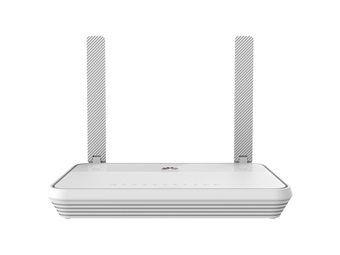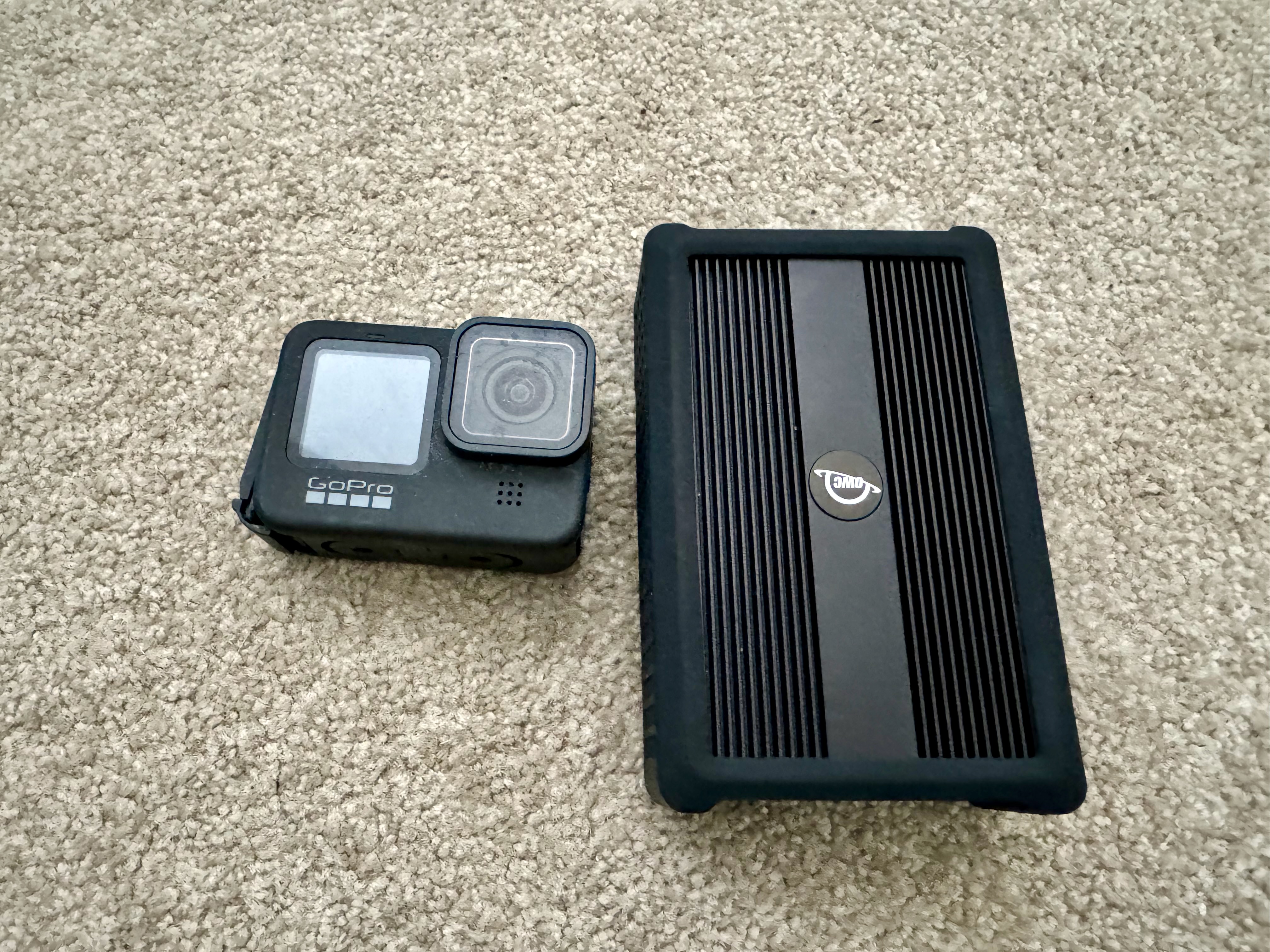
Here’s some cool network tech that popped up on the radar in a roundabout way: fibre to the room, or FTTR. The roundabout way was a presentation by Huawei at the recent New Zealand Network Operators Group (NZNOG) conference, which showed how to deploy FTTR in a neat and easy manner.
The long story short here is that Huawei and others have worked out how to extend the fibre to the premises (FTTP) network that your Internet provider offers, and make it reach inside your home or business.
This is the point where many in the audience reflexively go “nobody needs that!” but cool your jets: there will be a separate piece on dimensioning IT stuff and getting by with the minimum required; this is not the one, so please be patient.
OK, so why bother with FTTR? To understand that, take a look at this device:

That’s the excellent Other World Computing 10 gigabit per second Ethernet adapter with a GoPro Hero 9 next to it for scale. The OWC 10GE brick gets you those fast network speeds to max out an Orcon 8/8 Gbps HyperFibre connection, but it’s quite a lump that totally harshes your laptop mobility mellow.
And of course, it needs a copper Ethernet cable, chunky category 6a or better. One issue with 10GE networking gear is that it uses more power than for example, gigabit equipment. The 10GE gear can run hot, and you don’t really want to use buzzing fans to cool it in a home or office environment.
It’s entirely doable to set up a wired 10GE network inside homes and business premises and lots of people do. The Ethernet cable reach is still a more than adequate 100 metres. Such a network will provide great performance to the machines you connect to it, and it’ll work better than a wireless mesh set up for Wi-Fi, where the signal transferring data to the router is subject to the usual hindrances like distance, wall and floor thickness, and so forth.
Retro-fitting premises that don’t have existing ducting or service conduits that are easily accessible means the brave sparky who accepts the wiring job will charge a lot for it as well because it’s likely to require a great deal of creativity so as not to look ugly.
We’re getting faster and faster Wi-Fi but wouldn’t it be great to bring that fast fibre-optic connection as close to the client devices as possible?
The good thing is that the above is not news to the networking and telecommunications industry, which is fully aware of people being adverse to cables snaking around everywhere. Ye olde International Telecommunication Union (ITU) released the g.fin standard for FTTR which gives vendors something to work with.
From a user’s perspective, you put in a fast Wi-Fi 7 access point and it connects to the world over fibre-optic data backhaul.
The result? Data-driven WfHers and colleagues will get a superbly consistent wireless multi–gigabit experience, along with always-on family members. They might even cease to throw their devices at you, The Involuntary Sysadmin, to protest the Wi-Fi not working well while Zooming. 8K streams in every room! One can always dream.
Here’s a Huawei promo video for its OptixStar system. What’s notable in the clip is the slimness of the transparent passive optical network (PON) cable, and that it’s bendable to a degree. Normally, you don’t bend fibre-optic cabling as this causes light signal losses.
The Huawei PON cable is heat-glued to skirting boards and where you route it along walls and corners, and it looks like a fair bit of toolkit is required. There are other systems in the works, including ones that have self-adhesive cabling so that customers can DIY the whole thing.
It’s also possible to get FTTR PON cabling that includes power wires, similar to current PoE copper cables. This lets you power devices connected to the end of the cable with no electricity plugs required for wall warts, which makes installation heaps easier.
Essentially, you’d be building a simplified PON with a master optical network terminal and slave ones in a residence or a small business site. While the installation of the Optix gear and cable doesn’t look too bad, we’ll see if Huawei gets back to us with some answers on how interoperable the FTTR PON is with other vendors so that you’re not locked into the Chinese telco giant’s on-premises equipment. Which of course Huawei wants everyone to buy.
Either way, this looks like Tidy Tech that’s unobtrusive, and which should work well with New Zealand’s fast UFB fibre optic connections, and help Internet providers deliver a consistently fast user broadband experience. China's already installing the tech in millions of premises, along with telcos in Europe and Latin America.
18 Comments
Back in my day 10 GbE devices were way smaller than that. And with the existing Cat7a cabling that is being installed in most new houses being good up to 100 Gbps (15 meters or 40 Gbps at 50 meters) I anticipate it’ll be 2or 3 decades before fiber inside houses is common. Especially because the cost of just upgrading your switches, routers & PCIE network cars will be much lower than replacing the old cables with fiber. Essentially people go to long lengths to avoid the cost of rewiring giving the incumbent tech an advantage, there are people using cat 5e to do 10Gbps networks over shorter < 20m spans just because the house was wired with cat 5e back in the day!
There are many houses still wired with 1960s wiring still in NZ. Just shudder to think of the fire risks. People will avoid rewiring at any point because the costs including the electrician hourly rates, Gib replacement, plastering, painting can cost more then decades of mobile services or even cheaper workaround equipment.
Gone are the days of rewiring when the old system is past its use by day was affordable and often done. Nowadays families will be lucky to have the money to repair any electric failures in a game of wack a mole (where the mole can spark fires underneath).
It took 25 years for consumer grade network adapters to go from 1Gbps being the norm to 2.5 Gbps being the norm. It likely take at least that long again before modern ethernet cables get left behind by consumer grade 100+ Gbps adapters, creating room for fiber to hustle in.
It’s hard enough to get a sparkly to use 23aAWG Cat6 or Cat6A in a new build… let alone fibre. Then imagine the cost of the switches and gear :-(
Wi-Fi 6 with a wired back haul should hopefully last for a few years.
Would be good to see an article on the TP-Link Omada range. Pretty well suited to the pro consumer at a price point that is reasonable so much more attainable to average Joe.
Powerline networking has been around for many years now, and it can come in handy for some situations when it works. I don't think you can compare it directly to the consistent high performance fibre provides though. If low-bandwidth copper cable connections could provide a fibre equivalent user experience, we'd still be on DSL.
No, powerline is horribly unreliable. I've installed it on four separate occasions, and every time it's lasted a few months before I've got too irritated by the reliability and replaced it.
I mean, it's awesome. There's power virtually everywhere so getting ethernet is a neat trick. But... the only places you ever want it are places that are too far away for wifi, and that in turns means they're towards the limits of powerline.
I find it hard to see the demand for this. Remember how processor speed doubled every couple years for decades, until it got good enough and has barely inched up for the last ten years. Same for storage and RAM. People want to browse the web and run excel, and there just isn't demand beyond that.
I have 2.5G ethernet and honestly, it's been a waste of money over 1G ethernet. I have no interest in upgrading to 5G or 10G. There just isn't a good use case (yet?) for getting that much data to a device. The closest I can think of is centralising your security camera processing. But most of those are run by PoE, so you'd be crazy to do anything except ethernet.
Laying ethernet around the house was a pain and tends to look ugly. If fibre can be laid more easily then that's interesting. It doesn't matter if fibre has a bandwith of 40Gb compared to ethernet with 10Gb when you only need 100Mb, but excess doesn't hurt either. Ethernet goes to 50m without too much trouble, whereas fibre can go ten times that at 1Gb/s.
It depends on what you do ...
For most people they need little more bandwidth than what it takes to keep a 4k TV's buffer full, about 25 Mbps. Four people in the house all watching 4k screens? About 100 Mbps.
And then there are some friends of mine involved in Big Data who want to work from home. They'd receive 3-6 backup tapes weekly (terra-bytes of data!) that 3 of them (occasionally more) number crunch using very, very high end 'PCs'. I could see WFH CGI effects people might likewise benefit. (I suspect data security issues may become the dominant factor in such 'work from home' setups.)
The way I tend to think about what bandwidth is required is 'screens' vs files. I.e. If you can get all your 'stuff' into the cloud (with the appropriate equipment that you need for your workloads!) then you're down to what a 'screen' requires, e.g. 25 Mbps for 4k TV. But once you're talking about shunting very large files, and/or highly specialized compute/storage requirements that cloud services don't provide, then fibre networks might become a godsend.
8k TVs take a minimum of 100 Mbps each. Four people streaming and maybe scrolling Facebook whilst they watch tv would easily take you to 500 Mbps. 16k TVs have started popping up in 2024 and they take 400 Mbps each, so 4 would be 1.6 Gbps. VR games take about 500Mbps (emulating your environment in about 4K resolution). Next gen sets look likely to saturate a 2Gbps connection all on their own.
Next generation tech ... but with little next generation content.
But sure. It'll come. 10 years? 20 years? 30 years? And maybe never as the demand simply won't exist.
Or maybe demand will exist but people will go to cinemas to watch and games arcades to play - just like in the 'old' days.
At the end of day - unless we can make humans eyes as sharp as eagles - not too many people will see much benefit to 8k TV let alone 16k TV. Likewise VR games - only the very fittest will play for long and most will be exhausted within 30 minutes. Ultimately we need to recognize the limitations of the human body, and while some advanced tech will become sought after for highly specific purposes, it may never become mainstream.
Read my comment again - especially the screen vs. file paragraph. This explains the cloud vs. local paradigm.
Effective Big Data processing requires highly specialized equipment and many companies don't want to invest in it as it is cheaper to 'share' it specialists who have both the equipment and skills to process it effectively. I used 'tapes' as an example above to keep it simple. But streams of data, often streamed from DB logs (or to mirrored DBs), are also used and these don't require huge internet pipes but still require special equipment and skills to process it effectively.
Obviously you have never met esports players and streamers and never had a more complex job then an excel spreadsheet (sorry old tech Clients from Hell joke there where excel spreadsheet users were treated as if they could barely add, had no tech understanding and did not even know what a database was, the joke got even more funny when more VB workarounds were added).
I shudder to think what you would resort to when 3d modelling for engineering design is needed. Or when you are trying to join a meeting with international clients. I suppose you would resort to air travel to their offices (all 5 of them at once rather then a simple remote meeting).
An architect company I know could not show clients plans because their office had such little ability to upload and show plans & changes in real time they had to rebook several meetings. Embarrassingly one client suggested a lower bandwidth heavy series of apps to use instead and they used that in the meeting successfully but that meant they had double the app costs and more time wasted when their office could not accommodate the requirements of their own app integration.
Thanks Juha. Always good to have the semi-retired grey cells tickled by the latest tech and where it can solve age old problems. Keep them coming. On that note:
This is the point where many in the audience reflexively go “nobody needs that!” but cool your jets: there will be a separate piece on dimensioning IT stuff and getting by with the minimum required;
I have no doubt that one (those?) will generate a huge number of comments. Really looking forward to them.
It could be a good retro-fit solution - but if you have the opportunity you could rout a slot in the back of the skirting boards for cables and attach the skirting with screws so they can be removed.
My father did that back in the 1960's for stereo cables and it works rather well for everything else. You just need to think ahead, and there are proprietary skirting board systems now available.

We welcome your comments below. If you are not already registered, please register to comment.
Remember we welcome robust, respectful and insightful debate. We don't welcome abusive or defamatory comments and will de-register those repeatedly making such comments. Our current comment policy is here.